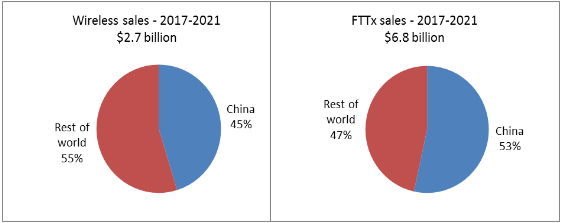Fiber Optic Connectors Market: Trends and Opportunities
Fiber optic connectors (FOC) are used to mechanically connect two optical fibers, thereby permitting light to transmit from the core of one fiber to the other fiber in order to link the fiber optic connection equipment.
The factors which are primarily driving the growth of global fiber optic connectors market are increasing demand for high bandwidth in the telecommunication industry and increasing demand for transmission speed and data volume in the data centers. The key features of fiber optical connectors such as low power consumption, cost effectiveness, and high data throughput are expected to fuel the growth of these connectors in the next generation warehouse-scale data center networks. In addition, the increasing application of these connectors in several application areas of the medical sector is playing a significant role in the growth of the global fiber optic connectors market. Furthermore, large scale production and technological advancements of fiber optics is also driving the growth of the global market. The conjoint effect of all these drivers and trends is therefore set to bolster the growth of the global fiber optic connectors market during the forecast period from 2016 -2024.
The rapid growth of the internet and cloud computing has resulted in bandwidth requirements for data center network. This is in turn expected to increase the demand for optical interconnects in the next-generation data center networks. Furthermore, advancements in fiber optic technology have led to the growth in requirement for optical sensors and data links in several applications including defense and aerospace.By deploying the advanced technologies in this field, the manufacturers can utilize this opportunity to increase production in a cost-effective manner as well as satiate the growing demand for fiber optic components among consumers. However, phenomenal growth in the wireless networking system is hampering the advancement of fiber optics. Moreover, the high cost and low level of automation of fiber optic connectors might also restrict the growth of the global market.
Fiber Optic Connectors Market: Scope of the Study
The global fiber optic connectors market has been segmented on the basis of types, applications and geography. A cross sectional analysis of the global fiber optic connectors market broadly across five geographical segments has also been covered under the scope this report.
A comprehensive analysis of the market dynamics which include, market drivers, restraints and opportunities has been included under the scope of this report. Market dynamics are the factors which influence the growth of the market and thereby help to understand the current trends in the market. The market drivers have been analyzed from the economic, demand and supply side. Therefore, this reports offers an exhaustive study on the global fiber optic connectors market and also provides the forecast of the market from 2016 – 2024.The present market size in terms of revenue (USD Million) along with forecast from 2016 to 2024 is also provided in this report. To provide a detailed insight into the market dynamics of the global fiber optic connectors market, market attractiveness analysis has been provided in the report.
Fiber Optic Connectors Market: Competitive Landscape
The competitive profiling of the leading players in the global market and their respective market shares across the five major geographic segments namely, North America, Europe, Asia Pacific, Latin America and Middle East and Africa have been covered under the purview of this report. In addition, the distinct business strategies which have been adopted by the key players have been included in the report.
Some of the major players in the fiber optic connectors market are Broadcom Limited (Singapore), 3M (The U.S.), Furukawa Electric Co. Ltd (Japan), Corning Cable Systems LLC (The U.S.), Alcatel-Lucent SA (France), Hirose Electric Co. Ltd (Japan), Hitachi Ltd. (Japan), Diamond SA (Switzerland), Arris Group Inc.(The U.S.), Sumitomo Electric Industries (Japan), Amphenol Corporation (The U.S.), Sterlite Optical Technologies Limited (India), TE Connectivity Ltd.(Switzerland), ZTE Corporation (China) and Ratioplast Electronics (Germany), among others.
The global fiber optic connectors market has been segmented into:
Fiber Optic Connectors Market, by Types
LC (Lucent Connectors, cleanned by one click cleaner LC)
SC (Standard Connectors , cleanned by one click cleaner SC)
ST (Straight Tip, ) Connectors
MPO/MTP (Multiple-Fiber Push-On/Pull-Off) Connectors , cleaned by Smart Cleaner MPO
MXC Connectors
Others
Fiber Optic Connectors Market, by Applications
Telecom Industry
Datacom
DWDM systems
Lasers
Others
Fiber Optic Connectors, by Geography – The market is broadly segmented on the basis of geography into:
North America
The U.S.
Canada
Mexico
Europe
United Kingdom
Germany
France
Spain
Italy
CIS
Scandinavia
Rest of Europe
Asia Pacific
China
India
Japan
Oceania
Rest of Asia Pacific
Latin America
Brazil
Argentina
Rest of Latin America
Middle East and Africa (MEA)
Saudi Arabia
UAE
South Africa
Rest of MEA
